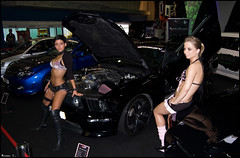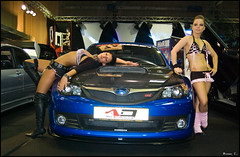 This year's Concorso d'Eleganza at Villa d'Este has its public day tomorrow, which is when the world will presumably get its first look at the new BMW M1 concept, a stunning, modern take on Munich's original supercar that is part of Bimmer's 30th anniversary celebration of the classic machine. The private exhibition took place today, however, and the guys at Asphalte.ch -- they were the first with live shots of the Lamborghini LP560-4 earlier this year -- have once again scored a coup, snapping the new, copper-colored M1 concept in all its glory, both alone and alongside its forebears. We expect to have a lot more on this car tomorrow (assuming a press kit will be released sometime overnight), but for now, head to Asphalte.ch to see more shots of the car under the lights. Hey BMW, just pull the trigger and greenlight a production version already, because this thing is awesome.
This year's Concorso d'Eleganza at Villa d'Este has its public day tomorrow, which is when the world will presumably get its first look at the new BMW M1 concept, a stunning, modern take on Munich's original supercar that is part of Bimmer's 30th anniversary celebration of the classic machine. The private exhibition took place today, however, and the guys at Asphalte.ch -- they were the first with live shots of the Lamborghini LP560-4 earlier this year -- have once again scored a coup, snapping the new, copper-colored M1 concept in all its glory, both alone and alongside its forebears. We expect to have a lot more on this car tomorrow (assuming a press kit will be released sometime overnight), but for now, head to Asphalte.ch to see more shots of the car under the lights. Hey BMW, just pull the trigger and greenlight a production version already, because this thing is awesome. BMW M1 Concept at Villa d'Este 2010
 This year's Concorso d'Eleganza at Villa d'Este has its public day tomorrow, which is when the world will presumably get its first look at the new BMW M1 concept, a stunning, modern take on Munich's original supercar that is part of Bimmer's 30th anniversary celebration of the classic machine. The private exhibition took place today, however, and the guys at Asphalte.ch -- they were the first with live shots of the Lamborghini LP560-4 earlier this year -- have once again scored a coup, snapping the new, copper-colored M1 concept in all its glory, both alone and alongside its forebears. We expect to have a lot more on this car tomorrow (assuming a press kit will be released sometime overnight), but for now, head to Asphalte.ch to see more shots of the car under the lights. Hey BMW, just pull the trigger and greenlight a production version already, because this thing is awesome.
This year's Concorso d'Eleganza at Villa d'Este has its public day tomorrow, which is when the world will presumably get its first look at the new BMW M1 concept, a stunning, modern take on Munich's original supercar that is part of Bimmer's 30th anniversary celebration of the classic machine. The private exhibition took place today, however, and the guys at Asphalte.ch -- they were the first with live shots of the Lamborghini LP560-4 earlier this year -- have once again scored a coup, snapping the new, copper-colored M1 concept in all its glory, both alone and alongside its forebears. We expect to have a lot more on this car tomorrow (assuming a press kit will be released sometime overnight), but for now, head to Asphalte.ch to see more shots of the car under the lights. Hey BMW, just pull the trigger and greenlight a production version already, because this thing is awesome. Toyota MR2 Hybrid Sports Car In the Offing 2010

There's a feeling among car fans that hybrid vehicles are set to kill the driver-oriented sportscar. But many skeptics were silenced when Honda took the wraps off of its CR-Z coup concept recently. After all, anything that could bring back the CRX hatchback with extra power at no extra cost at the fuel pumps has to be pretty good right? Now it seems Toyota wants in on some of that hybrid sports car action.
Recent reports out of Japan are suggesting that Toyota may be working on a reborn hybrid sportscar of its own. The company once known for its sports-coupes recently unveiled the FT-86 concept, and might be ready to follow up with a gasoline-electric resurrection of the cult classic MR2. The budget-friendly mid-engine/rear-drive sportscar had a big following right up until the third-generation model was discontinued two years ago. But if the latest reports are to be believed the old MR2 is set for a hybrid comeback.
Toyota MR2 Hybrid Sports Car In the Offing 2010

There's a feeling among car fans that hybrid vehicles are set to kill the driver-oriented sportscar. But many skeptics were silenced when Honda took the wraps off of its CR-Z coup concept recently. After all, anything that could bring back the CRX hatchback with extra power at no extra cost at the fuel pumps has to be pretty good right? Now it seems Toyota wants in on some of that hybrid sports car action.
Recent reports out of Japan are suggesting that Toyota may be working on a reborn hybrid sportscar of its own. The company once known for its sports-coupes recently unveiled the FT-86 concept, and might be ready to follow up with a gasoline-electric resurrection of the cult classic MR2. The budget-friendly mid-engine/rear-drive sportscar had a big following right up until the third-generation model was discontinued two years ago. But if the latest reports are to be believed the old MR2 is set for a hybrid comeback.
TESLA sports car in action 2010
It's not often you get told to put your foot down on a test drive but that's what happened last week when I test drove a Tesla electric sports car.
Electric cars seemed like an engineer's pipe dream only a few years ago, now they're becoming a reality.
Only yesterday Nissan announced its Leaf hatchback which could be built at the Sunderland plant and is expected to go on sale in 2011.
The 120 mph Tesla is already on the roads and selling well for a £94,000 sports car.
It has been deliberatley designed to be eco cool and "could only have come out of Silkicon Valley" Not surprisingly, the first owners are London eco pioneers.
The newly opened London showroom is selling four a month.
But back to the test drive. Like all electric cars it's very simple to drive. Accelerator, break and just neutral forward and back.
It's when you put your foot down you get the full thrill of the instant acceleration. All torque and lots of action, as you might say.

It's got a range of 200 miles, re-charge centres are springing up and if you do get stuck there's a rescue service.
My only regret was the 30 mph and 40 mph speed signs within range of Canary Wharf which stopped me putting my foot on the floor.
TESLA sports car in action 2010
It's not often you get told to put your foot down on a test drive but that's what happened last week when I test drove a Tesla electric sports car.
Electric cars seemed like an engineer's pipe dream only a few years ago, now they're becoming a reality.
Only yesterday Nissan announced its Leaf hatchback which could be built at the Sunderland plant and is expected to go on sale in 2011.
The 120 mph Tesla is already on the roads and selling well for a £94,000 sports car.
It has been deliberatley designed to be eco cool and "could only have come out of Silkicon Valley" Not surprisingly, the first owners are London eco pioneers.
The newly opened London showroom is selling four a month.
But back to the test drive. Like all electric cars it's very simple to drive. Accelerator, break and just neutral forward and back.
It's when you put your foot down you get the full thrill of the instant acceleration. All torque and lots of action, as you might say.

It's got a range of 200 miles, re-charge centres are springing up and if you do get stuck there's a rescue service.
My only regret was the 30 mph and 40 mph speed signs within range of Canary Wharf which stopped me putting my foot on the floor.
World’s Fastest Street Legal Sports Car 2010

Swiss car maker Weber Sportscars is billing its latest creation, the “faster one,” as the world’s fastest street legal sports car. Powered by a 900-horsepower/774 lb-ft twin-supercharged V8, the faster one does 0-62 mph in 2.7 seconds, 0-124 in 6.6 seconds, 0-186 in 16.2 seconds, and it hits a top speed over 248 mph (comparable to the Bugatti Veyron).
The car’s design is distinguished by a motorized rear wing, which doubles as an air brake when necessary, similar to the Veyron’s. Yet, unlike the Veyron, the styling resembles more of a suped-up rice rocket than a work of sophisticated European engineering.
For 1.6 million Swiss Francs (U.S. $1.55 million), Weber will build you your own faster one. So, at least you’ll save a little more than $100K as compared with the $1.67 million Veyron. But, for your money, which would you rather park in your garage?
World’s Fastest Street Legal Sports Car 2010

Swiss car maker Weber Sportscars is billing its latest creation, the “faster one,” as the world’s fastest street legal sports car. Powered by a 900-horsepower/774 lb-ft twin-supercharged V8, the faster one does 0-62 mph in 2.7 seconds, 0-124 in 6.6 seconds, 0-186 in 16.2 seconds, and it hits a top speed over 248 mph (comparable to the Bugatti Veyron).
The car’s design is distinguished by a motorized rear wing, which doubles as an air brake when necessary, similar to the Veyron’s. Yet, unlike the Veyron, the styling resembles more of a suped-up rice rocket than a work of sophisticated European engineering.
For 1.6 million Swiss Francs (U.S. $1.55 million), Weber will build you your own faster one. So, at least you’ll save a little more than $100K as compared with the $1.67 million Veyron. But, for your money, which would you rather park in your garage?
Porsche adds power to its Cayman S sports car 2010

The company has invested some money in its potent mid-level sports car, the Cayman, which debuted in 2005 as a 2006 model. Four years into the model run, Porsche has freshened the 2009 Cayman with a mild restyling of the front and rear — headlights and taillights mostly — and has added power.
The base Cayman gets a larger, 2.9-liter six-cylinder engine, with 265 horsepower. And the uplevel Cayman S now has a 3.4-liter six-cylinder engine, with horsepower boosted from 295 to 320. The Cayman S still isn't playing in the same league as the flagship 911, but it's closer than ever.
On the Cayman S test car, that new engine is matched with a new seven-speed "Doppelkupplung" transmission — that translates to "double clutch," meaning that while this transmission operates as an automatic, it can be shifted manually, thanks to internal clutches. It's an effective update of the Tiptronic transmission, but whether you think it's worth the $3,420 option price over the six-speed manual is up to you.
There is no denying, though, that this new transmission maximizes the engine's muscle, and it feels like more than 320 horsepower, pulling strongly from a standing start, up through and well past legal limits. And fuel mileage is surprisingly good: An EPA-rated 20 mpg city, 29 mpg on the highway, thanks in part to that seventh speed that lets the engine lope along at freeway speeds.
The handling is excellent and the ride is surprisingly good. Steering is quick but not twitchy. Brakes are superb.
BMW’s Green Sports Cars 2010

“It’s the sports car of the future, the way BMW imagines it.” That’s how Adrian van Hooydonk, director of BMW’s group design, describes the “BMW Vision Efficient Dynamics” two-door concept vehicle to be unveiled at the upcoming Frankfurt Auto Show. Think of it as a showcase of the many fuel-efficient technologies that BMW has in various stages of development. Some of the technologies already appear in production vehicles, while the feasibility of rolling out other systems stretch the future to the point of never.
BMW’s overarching goal was to combine breath-taking speed and groundbreaking efficiency. In the BMW Vision, that boils down to 4.8-second 0-to-60 miles per hour acceleration and 63 mile to the gallon.

First, BMW engineers use the rear-axle to combine a turbo-charged small diesel engine and the mildest forms of hybrid technology. That kind of combo comes standard in BMW 1-series cars in Europe. The Vision's setup is a little more similar to the BMW 320d, also to debut in Frankfurt, which uses a 2.0-liter four-cylinder diesel to deliver 162 horsepower, while promising more than 57 miles to the gallon. The BMW Vision takes it a step further by downsizing the engine to a 1.5-liter three-cylinder diesel engine mated with the more robust hybrid system found in the pricey BMW ActiveHybrid7, expected in the US early next year.
Not satisfied with 162 horsepower, BMW adds a second motor to drive the front wheels exclusively by electricity. When both motors and the diesel engine are called into service, the overall system can put out 356 horsepower. The BMW Vision is lightweight and aerodynamic. The design features an aluminum chassis and suspension, and an outer skin made mostly of polycarbonate glass. The car’s slippery design boasts a drag coefficient of 0.22—beating out the Toyota Prius’s 0.25.

To mitigate the fuel efficiency penalty paid for power, the BMW Vision utilizes plug-in hybrid technology. This is where the Vision becomes more of a fantasy. The combination of diesel and hybrid technologies is widely viewed as cost prohibitive. Adding enough battery power to allow the BMW Vision EfficientDynamics to travel for 30 miles of all-electric drive, as BMW is promising, would send costs through the roof.
BMW also indicates that the Vision only needs a 187-pound 10.8 kWh battery to achieve the 30-mile all-electric goal. To pull that off, the Vision, according to BMW, will discharge the battery pack's capacity by 80 percent, which is likely to significantly reduce the longevity of the battery. (The Chevy Volt will use about 50 percent of its capacity to help ensure a lifetime of use.)
BMW’s Green Sports Cars 2010

“It’s the sports car of the future, the way BMW imagines it.” That’s how Adrian van Hooydonk, director of BMW’s group design, describes the “BMW Vision Efficient Dynamics” two-door concept vehicle to be unveiled at the upcoming Frankfurt Auto Show. Think of it as a showcase of the many fuel-efficient technologies that BMW has in various stages of development. Some of the technologies already appear in production vehicles, while the feasibility of rolling out other systems stretch the future to the point of never.
BMW’s overarching goal was to combine breath-taking speed and groundbreaking efficiency. In the BMW Vision, that boils down to 4.8-second 0-to-60 miles per hour acceleration and 63 mile to the gallon.

First, BMW engineers use the rear-axle to combine a turbo-charged small diesel engine and the mildest forms of hybrid technology. That kind of combo comes standard in BMW 1-series cars in Europe. The Vision's setup is a little more similar to the BMW 320d, also to debut in Frankfurt, which uses a 2.0-liter four-cylinder diesel to deliver 162 horsepower, while promising more than 57 miles to the gallon. The BMW Vision takes it a step further by downsizing the engine to a 1.5-liter three-cylinder diesel engine mated with the more robust hybrid system found in the pricey BMW ActiveHybrid7, expected in the US early next year.
Not satisfied with 162 horsepower, BMW adds a second motor to drive the front wheels exclusively by electricity. When both motors and the diesel engine are called into service, the overall system can put out 356 horsepower. The BMW Vision is lightweight and aerodynamic. The design features an aluminum chassis and suspension, and an outer skin made mostly of polycarbonate glass. The car’s slippery design boasts a drag coefficient of 0.22—beating out the Toyota Prius’s 0.25.

To mitigate the fuel efficiency penalty paid for power, the BMW Vision utilizes plug-in hybrid technology. This is where the Vision becomes more of a fantasy. The combination of diesel and hybrid technologies is widely viewed as cost prohibitive. Adding enough battery power to allow the BMW Vision EfficientDynamics to travel for 30 miles of all-electric drive, as BMW is promising, would send costs through the roof.
BMW also indicates that the Vision only needs a 187-pound 10.8 kWh battery to achieve the 30-mile all-electric goal. To pull that off, the Vision, according to BMW, will discharge the battery pack's capacity by 80 percent, which is likely to significantly reduce the longevity of the battery. (The Chevy Volt will use about 50 percent of its capacity to help ensure a lifetime of use.)






























